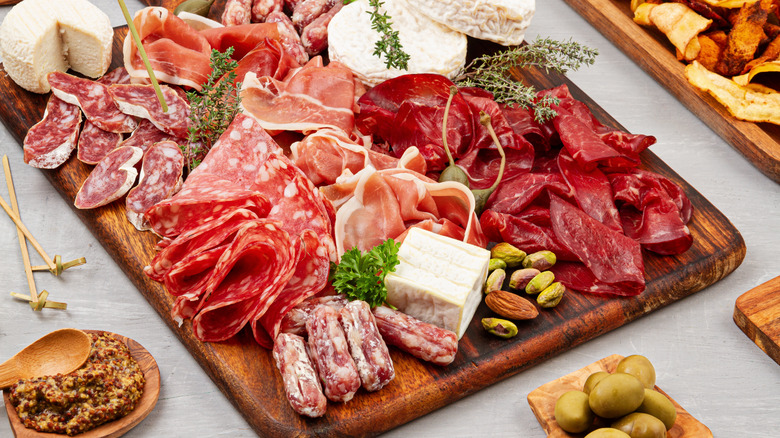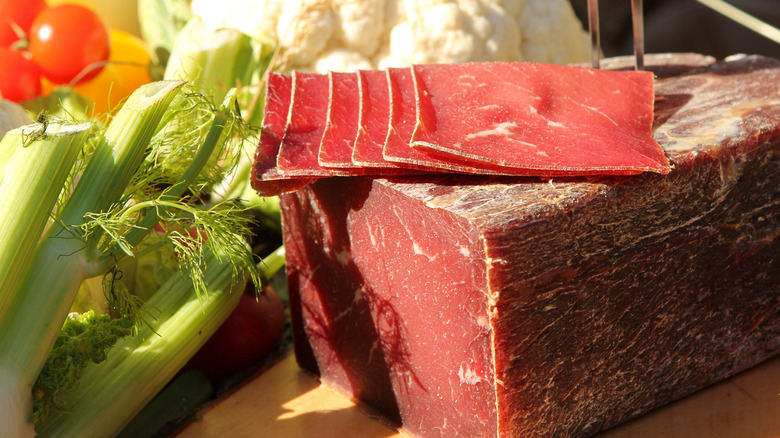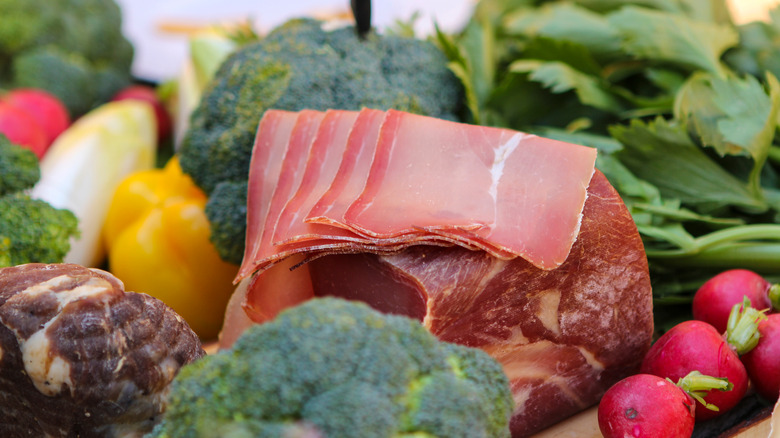The Swiss Delicacy You Need For Your Next Charcuterie Board
Charcuterie boards often call for a variety of cured meats to pair nicely with the usual cheese, crackers, and spreads. Reaching for a pack of prosciutto is almost second-nature, but if you're looking to expand your palate and knowledge of global eats, Bündnerfleisch could be the star of your next charcuterie board.
Bündnerfleisch, a cured beef product, has origins in the Graubünden region of Switzerland, an area also known for the scenic yet challenging alpine slopes of St. Moritz (via Swiss House Shop). Like other cured meat products, the preparation process takes time, care, and tact, but the result is a finished product that is nothing less than indulgent. Seasoned, cured for months, and sliced thinly to accompany your charcuterie board or caquelon of bubbling Gruyère, Bündnerfleisch is a Swiss delicacy. You're able to purchase it online for shipment, but if you want fresh cuts, it's worth looking into specialty delis located in your area.
How is Bündnerfleisch made?
There's a cured meat for nearly every part of the world. In Italy, there's an assortment of salumi; in Spain, there's chorizo; the list goes on. For Switzerland, Bündnerfleisch follows suit, but unlike the prior examples, it's not made from pork.
The process starts with a cut of beef, specifically one from a cow's upper thigh or shoulder (via Swiss House Shop). Prior to curing, any streaks of fat and sinew are removed, and the meat is often marinated in white wine, seasonings, alpine herbs, onion, and salt. It's then sealed in a container and stored in near-freezing temperatures for the initial curing process, which generally lasts three to five weeks, per Fooby. During this time, the meat is often flipped, pressed and moved around to disperse flavors while also squeezing out excess moisture. This also gives the meat its characteristic rectangular shape.
After the initial curing period, the meat is rinsed and hung in an area with low temperatures to air-dry further — Gastro Chemist notes this process can take anywhere between 12 and 24 weeks. The final product is a deep red or plum-colored Swiss Bündnerfleisch with slight notes of salt and spice.
How does Bündnerfleisch fit into Swiss cuisine?
Perhaps cured meat isn't the first dish that comes to mind when you think of Swiss food. Instead, chocolate and cheesy offerings like fondue and raclette tend to be the foods most commonly associated with the country (via BBC Good Food). But cured meats also have a significant place in Swiss cuisine.
In Switzerland, Bündnerfleisch is typically accompanied by Mostbröckli and Viande séchée, two similar forms of cured beef (via Gastro Chemist). According to Taste Atlas, walliser rohschinken and jambon de la borne — cured pork delicacies — are popular as well.
Serving Bündnerfleisch is comparable to serving other forms of specialty cured meats. It's usually sliced extremely thin and can be eaten alone, atop a piece of bread, or baked into other dishes. Since Bündnerfleisch is low in fat and carbohydrates and high in protein and iron, it's also a popular addition to cheese-heavy dishes like fondue or raclette, a Swiss melting cheese, according to Fooby. And, of course, it's an exciting and delicious addition to any charcuterie board. En Guete!


